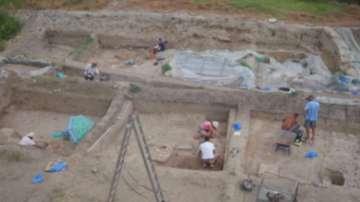A great scientific sensation – Bulgarian archaeologists discovered gold in the village of Yunatsite, near the South Bulgarian town of Pazardzhik, which had been processed in Chalcolithic Necropolis of Varna (Varna cemetery). This means that the gold bead discovered in the City of Birds in Yunatsite becomes the oldest gold in Europe.
The discovery will change the reading frame of the history of our lands. The people who lived in the city of Birds 8,000 years ago were part of a very developed culture and civilization.
It is a tiny gold bead but big enough to find its place in history and attract the attention of researchers not only in Bulgaria, the archaeologists explain.
The horizon in which it was found refers to the middle Halkolite Epoch, 200-300 years earlier than Varna Necropolis, which is from the late Halkolite. The archaeologists have lots of knowledge about the skills and life of the people from those times. They arrived from Asia Minor, settled in a place between three mountains and two rivers. Not a lot has remained from their houses, which were made from wooden rods and clay. But the signs of high level or organization and even the beginning of specialized production are clear: 7 stones for grinding of wheat.
Every milimetre of the clay layers carries some information. The archaeologists are working very carefully and instead of a shovel, vacuum cleaner is their main instrument.
According to the researchers, the cult of these people towards birds is clear. They found many bird-man clay figures.
It seems that the people there believed the birds were their ancestors. Probably the place was full of birds. And that is why the people called it the City of Birds - a city, not a settlement. It had a stronghold, streets and public markets, with traces of wealthy and carefree life in which there even was room for art. Until 6,000 years ago, when the city was attacked by primitive tribes, which according to Yavor Boyadzhiev had a great advantage and this was the horse. He explained that they tamed horses and arrived as cavalry.
Boyadzhiev added that skeletons were found with traces of holes caused by stone battle axes. The battle was uneven - brutal force against peaceful farmers committed to spiritual life and culture, and accustomed to indulgence. The City of Birds was destroyed and burnt.









 Чуй новините
Чуй новините Подкаст
Подкаст





















